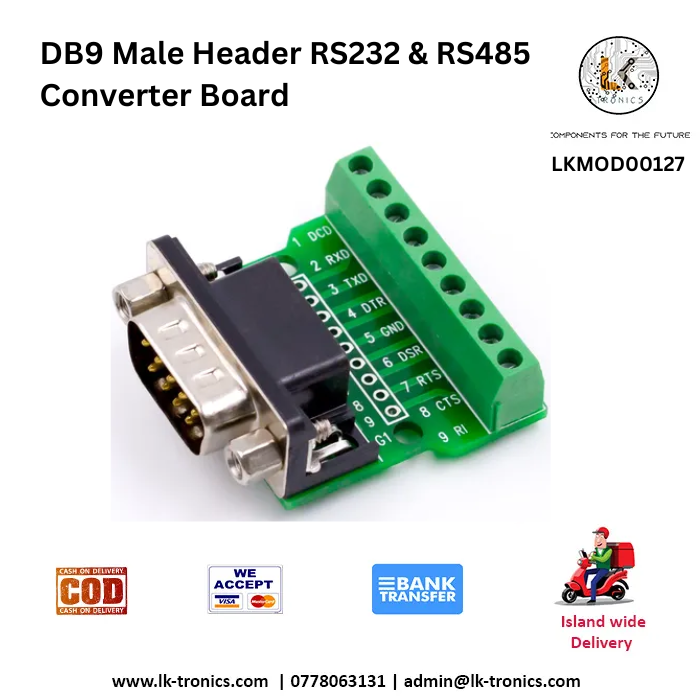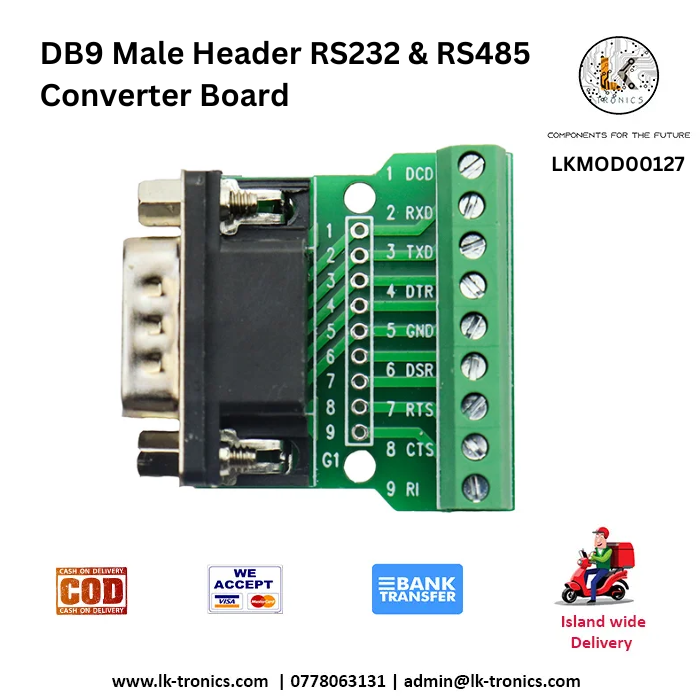DB9 Male Header RS232 & RS485 Converter Board
Specifications:
1. Interface:
- RS232: DB9 Male connector
- RS485: Terminal block (typically 2-wire A and B lines for half-duplex communication)
2. Communication Protocol:
- RS232 to RS485 conversion: Converts standard RS232 signals to RS485.
- Half-duplex: RS485 is typically half-duplex, meaning data can flow in one direction at a time.
3. Data Rates:
- RS232: Up to 115200 bps (can vary depending on the device)
- RS485: Supports baud rates from 300 bps to 115200 bps, depending on the application.
4. Operating Modes:
- Automatic Direction Control (for RS485): Automatically controls the direction of data flow without the need for external control signals (like RTS) for half-duplex operation.
5. Power Supply:
- Can be powered through:
- External DC Supply: 5V or 12V depending on the design.
- Power through the RS232 port: Some designs can draw power directly from the RS232 port (check compatibility).
- Current Consumption: Typically, less than 50 mA.
6. Pinout (DB9 Male Connector RS232 side):
- Pin 2: RXD (Receive Data)
- Pin 3: TXD (Transmit Data)
- Pin 5: GND (Signal Ground)
- Pin 7: RTS (Request to Send) – optional for some designs
- Pin 8: CTS (Clear to Send) – optional for some designs
7. Pinout (RS485 side):
- A: RS485 Data A (Differential +)
- B: RS485 Data B (Differential -)
- GND: Ground (optional, depending on the system)
8. Isolation:
- Optical Isolation (optional): Some converters use optical isolation to protect the RS232/RS485 circuits from electrical surges, grounding issues, or other electrical noise common in industrial settings.
9. Surge Protection:
- Surge protection and ESD protection are often integrated to handle high-voltage transients on the RS485 side.
- TVS Diodes: Protection for ESD (Electrostatic Discharge) and surge protection.
10. Distance:
- RS485 Communication Distance: Up to 1200 meters (4000 feet) at lower baud rates (e.g., 9600 bps). Higher baud rates decrease the maximum distance.
- RS232 Communication Distance: Typically up to 15 meters (50 feet).
11. Termination Resistor:
- RS485 networks often require a termination resistor at each end of the communication line to minimize signal reflections. Some boards include a built-in resistor that can be enabled/disabled via a jumper.
12. Temperature Range:
- Operating Temperature: -40°C to +85°C
- Storage Temperature: -55°C to +125°C
13. Compatibility:
- Compatible with a wide range of RS232 and RS485 devices such as microcontrollers, PLCs, PCs, and industrial machines.
14. PCB Layout:
- Compact PCB design with mounting holes for easy integration into industrial systems.
- Dimensions: Typically small form factor (e.g., 50mm x 40mm, but varies by model).
15. LED Indicators:
- Power LED: Indicates power to the board.
- TX/RX LEDs: Shows data transmission and reception status on the RS485 bus.
16. Mounting Options:
- Through-hole or header pins for easy mounting on development boards or enclosures.
17. Applications:
- Industrial automation
- Data acquisition systems
- SCADA (Supervisory Control and Data Acquisition)
- HVAC control systems
- Remote device monitoring
VISIT OUR FACEBOOK PAGE FOR MORE INFO | MORE PRODUCT IN OUR SHOP
Based on 0 reviews
Be the first to review “DB9 Male Header RS232 & RS485 Converter Board”
You must be logged in to post a review.












There are no reviews yet.